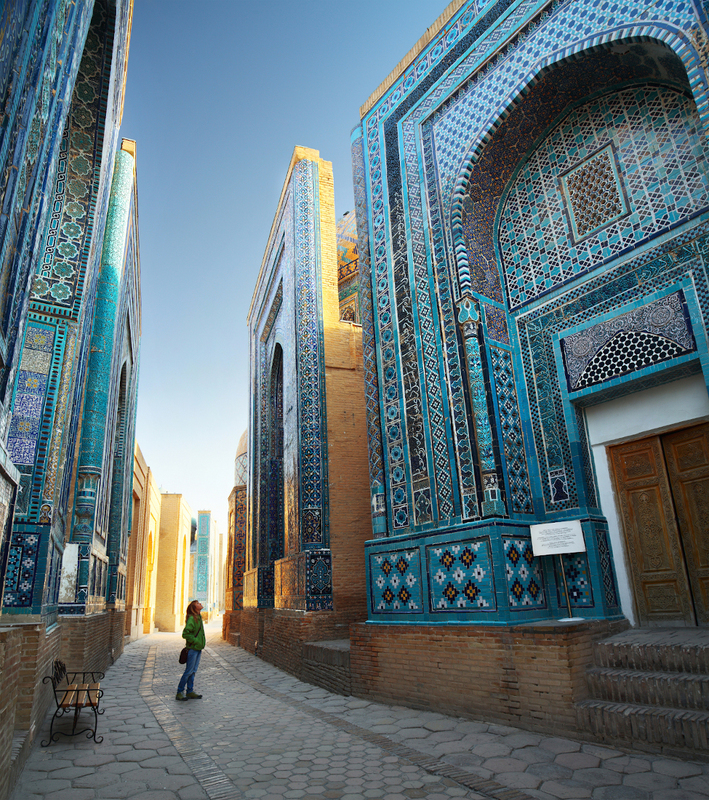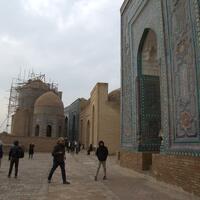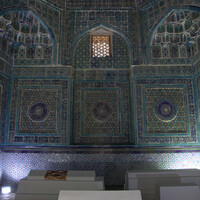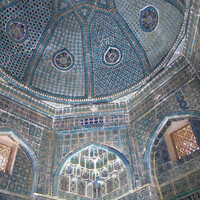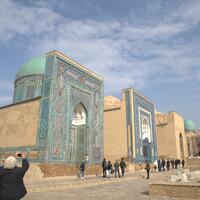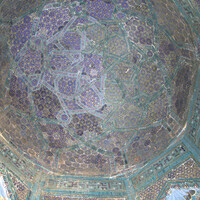Shah-i Zinda tiled tombs
Type:
Cemeteries,
Cenotaphs,
Mausoleums,
Pishtaqs,
Religious Complexes,
Tiles
Date:
Eleventh to fifteenth century
Location or Findspot (Modern-Day Country):
Uzbekistan
Description:
The Shah-i Zinda is a 200-meter-long street of tiled tombs on the Afrasiab hill outside of Samarkand (Uzbekistan). The focus of the complex is the tomb of Qusam ibn Abbas, a cousin of Muhammad, who was killed nearby during the Islamic conquest of Central Asia in the seventh century. Qusam supposedly carried his head to his burial place (St. Denis allegedly did the same in France), and he became known as the living king, the shah-i zinda. The earliest tombs date to the eleventh century, but most belong to the Timurid period, when the tombs were built for female members of Timur's family between 1370 and 1405. Timur's grandson Ulugh Beg erected a monumental gateway at the south entrance to the street in 1434/5.
There were about forty tombs originally, mostly square in plan, preceded by a tall pishtaq and topped by a double-shell dome. The graves are below floor level, marked by a cenotaph in the tomb chamber. Tile decoration is concentrated on the facade and interior and consists of geometric and floral ornament and Arabic inscriptions drawn from the Qur'an. Shown here are details of two of the tombs. The Shad-i Mulk Aga Mausoleum (1371–83) was built for a niece of Timur by her mother; three artists' names are preserved in addition to those of the patron and the occupant. The dome interior is decorated with pseudo-ribs that emanate from an eight-pointed tiled star. The Anonymous Mausoleum (ca. 1380) contains an unknown occupant, but the architect's name, Ali Nasafi, is visible on the facade. Muqarnas squinches make the transition from the square chamber to the intricately tiled dome.
There were about forty tombs originally, mostly square in plan, preceded by a tall pishtaq and topped by a double-shell dome. The graves are below floor level, marked by a cenotaph in the tomb chamber. Tile decoration is concentrated on the facade and interior and consists of geometric and floral ornament and Arabic inscriptions drawn from the Qur'an. Shown here are details of two of the tombs. The Shad-i Mulk Aga Mausoleum (1371–83) was built for a niece of Timur by her mother; three artists' names are preserved in addition to those of the patron and the occupant. The dome interior is decorated with pseudo-ribs that emanate from an eight-pointed tiled star. The Anonymous Mausoleum (ca. 1380) contains an unknown occupant, but the architect's name, Ali Nasafi, is visible on the facade. Muqarnas squinches make the transition from the square chamber to the intricately tiled dome.
Relevant Textbook Chapter(s):
10
Repository and Online Resources:
• Samarkand is a UNESCO World Heritage site.
• Read about the Shad-i Mulk Aga Mausoleum here.
• Read about the Anonymous Mausoleum here.
Image Credits:
Depositphotos (mihtiander) and Linda Safran
